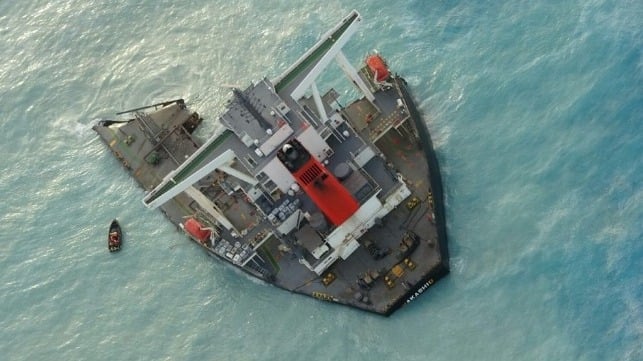MOL Safety Plan Addresses Complacency and Overconfidence on Wakashio

Nearly five months after the grounding of the bulk carrier Wakashio off the island of Mauritius, Mitsui O.S.K. Lines (MOL) which had chartered the vessel, announced its action plan designed to enhance its safety processes and culture aboard its ship and ones it charters. While saying the investigation is still ongoing, the company confirmed what many people believed were the causes of the accident and subsequent oil spill and environmental disaster in developing its plan.
Saying it was based on information the shipowner, Nagashiki Shipping Co., had obtained from the crew, MOL identified issues it termed as complacency and overconfidence leading to not preparing an appropriate passage plan, not using the correct navigational map, and neglecting visual and radar watchkeeping.
Two days before the grounding, MOL reported that the Wakashio changed her passage plan that would have had her 22 nautical miles from the island to a new plan to be with five nautical miles of Mauritius. On the day of the grounding, the plan was again altered to sail two nautical miles offshore to enter an area within the communication range of mobile phones.
The crew did not own the correct navigation chart for the planned approach to Mauritius and instead used a nautical chart without a sufficient scale to confirm the accurate distance from the coast and water depth. In addition, a crewmember neglected appropriate watchkeeping, visually and by radar, MOL says, even though the ship was trying to sail two nautical miles off the coast.
The statement cites only these issues resulting in the ship running aground in shallow water less than a mile off the coast of Mauritius. Statements from Panama as the flag state and reports in the media also suggested that there was a crew birthday party underway at the time of the grounding and that officers might not have been present on the bridge or distracted before the grounding.
MOL, however, cites overconfidence that stems from complacency, saying that the Wakashio had on several prior occasions approached other coasts before the grounding. “In MOL's view, such behavior on a large vessel reflects a lack of safety awareness,” the statement says. “Another reason behind the cause is that the crewmembers lacked awareness of the guidelines on performing navigation in a safe manner and their efforts to conform were insufficient,” the statement continues.
Based on what it believes were the probable causes of the grounding, MOL says it will invest the equivalent of approximately $4.8 million on education programs, steps to ensure better compliance by its crews and on charter vessels, and upgrades to the ships’ systems. That is in addition to the nearly $10 million in aid MOL pledged to Mauritius and the company’s donations of personnel, time, and services to support the recovery effort on the island.
One of the areas that came in for criticism aboard the Wakashio and many other ships, especially during the pandemic is the lack of onboard communication systems to permit the crew to remain in contact during the prolonged periods at sea. MOL committed to upgrading and installing high-speed and large-capacity communication systems on MOL vessels and requesting that shipowners do the same on any vessels it charters.
The other critical change is a plan to introduce a service plan for MOL vessels, which allows browsing of worldwide electronic charts at all scales, without requiring the purchase of the chart. Shipowners of chartered vessels will also be requested to implement this plan.
The educational programs will address the lack of safety awareness with steps including a safety campaign, meetings with crew, and education on the operation of electronic nautical charts. They will also conduct a safety awareness survey and take further steps based on the findings.
On shore, they committed to enhanced involvement with shipowners as well as enhanced support for the ships and inspections. They will re-develop the watchkeeping operational manual to reinforce the 24-hour monitoring system, including a new grounding risk monitoring system. Shore staff will also check personal histories when changing senior officers and hold briefings with senior officers.
Trials are also underway on some MOL vessels using monitoring cameras on the bridge as an increased deterrent and to ensure implementation and adherence to the safety protocols. MOL says it will examine the installation of cameras on all its vessels, after verifying the effectiveness of the trials.
They concluded by saying, “every MOL Group member must take to heart the message that safe operation is the major premise for corporate activities and work to prevent the reoccurrence of this incident.”
